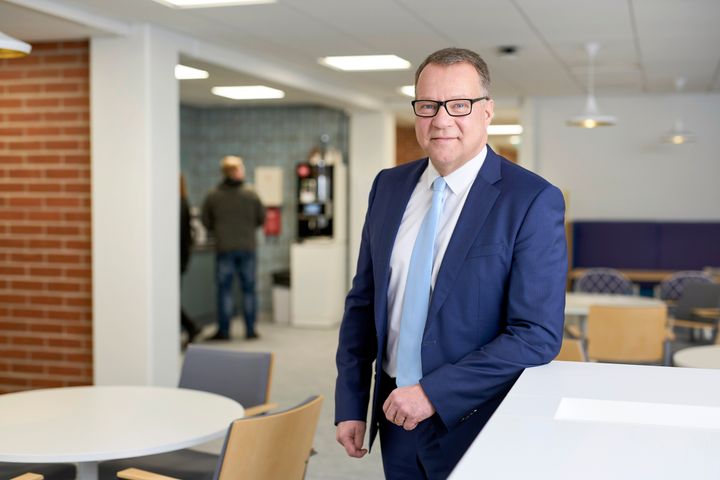Mayor Jukka Mäkelä’s budget proposal for 2021: Espoo will secure services for residents, in spite of major challenges posed by the coronavirus

The city’s operating expenses have increased considerably more than tax funding, and the level of investments is high. Espoo’s population will continue to grow by about 4,500 new residents per year. Over the next ten years, Espoo’s population structure will change and the dependency ratio will rise. It is expected that population growth will not result in increasing tax revenue as before.
According to the budget proposal for 2021, it is expected that tax funding, i.e. revenues from taxes and central government transfers to local government, will be lower than in 2020 as the state’s coronavirus compensation will decrease. The growth of operating expenses will significantly exceed the amount of tax funding, and the result is estimated to be EUR −43 million in 2021. It is predicted that the result will not be positive until 2023.
Responding to the population growth will still require significant investments. The City of Espoo’s investment programme will have a total budget of EUR 2.5 billion for 2021–2030. In addition to schools and day care centres, the programme includes traffic route and public transport projects required for the growth of the city and for the development of the urban structure, such as the Jokeri Light Rail, the City Rail Link and the metro development corridor.
Cash flow financing will cover 40 per cent of the investments at the beginning of the financial plan period and 70 per cent at the end of the period. The city’s loan portfolio will increase by EUR 0.5 billion during the financial plan years 2021–2023.
The result of the Corporate Group of Espoo is expected to be clearly in deficit in 2021 and 2022 and remain negative until 2029. The group’s investments will total EUR 4.7 billion and the group’s loan portfolio will increase to EUR 5.4 billion by 2024, after which it will start decreasing.
“In the future, the state should take better account of the investment needs of growing cities and the costs of a multilingual service structure in the central government transfer system or other financing systems. Espoo’s taxpayers significantly support the economy of other Finnish municipalities through both state and local income taxation, while the growing City of Espoo gets further into debt. This cannot continue,” Mäkelä says.
In addition, the possible health and social services reform would significantly weaken the economy of Espoo and the entire Western Uusimaa area. “To put it simply, the reform would take our revenue but leave our debt,” Mäkelä says. The reform solution has not been taken into account in the budget proposal calculations.
To correct the economic imbalance and to control indebtedness, the City Council decided on the Economically Sustainable Espoo productivity and adjustment programme. The objective of the programme is to balance the operational economy by EUR 147 million by the end of 2025. In addition, the level of investments will be reduced by 10 per cent, with annual investments totalling EUR 250 million, on average.
“The same process of economic adjustment and improving productivity is underway in all major cities,” Mäkelä says.
The City of Espoo aims to be carbon-neutral by 2030 and is one of the forerunners in implementing the UN’s Sustainable Development Goals (SDGs). According to the City of Espoo’s Sustainable Energy and Climate Action Plan (SECAP), it is possible to achieve carbon neutrality if both the city and its partners actively work towards the goal. Espoo’s climate work is managed through the city’s economic and operational planning, in line with the SECAP. The measures planned and implemented by the city to reduce emissions can be found in the budget, the units’ plans and scorecards.
Further information
Mayor Jukka Mäkelä, tel 046 877 3953
Financial Planning Director Pia Ojavuo, tel 043 826 9139
Keywords
Images

Links
About Espoon kaupunki - Esbo stad
 Espoon kaupunki - Esbo stad
Espoon kaupunki - Esbo stadPL 1 / PB 1
02070 ESPOON KAUPUNKI / ESBO STAD
+358 9 816 21http://www.espoo.fi
Subscribe to releases from Espoon kaupunki - Esbo stad
Subscribe to all the latest releases from Espoon kaupunki - Esbo stad by registering your e-mail address below. You can unsubscribe at any time.
Latest releases from Espoon kaupunki - Esbo stad
Espoon uusivuosi 2026 tarjoaa maailmanluokan valotaidetta ja koko perheelle suunnattua ohjelmaa19.12.2025 12:17:54 EET | Tiedote
Espoon uuttavuotta juhlitaan Tapiolan keskuksen alueella keskiviikkona 31.12.2025 kello 17–22. Tapiolan Jääpuutarhassa sijaisteva valotaideteos on mahdollista kokea sekä jalkaisin että luistellen revontulten maagisen loisteen alla, kun sveitsiläisen taiteilijan Dan Acherin teos Borealis valaisee taivaan. Lisäksi Tapiolan Keskusaltaan ympäristössä ja Espoon Kulttuurikeskuksessa on paljon monipuolista ohjelmaa, kuten disko, karuselli, DJ-musiikkia sekä valo- ja mediataidetta.
Marjo Poutanen on valittu KAMU Espoon kaupunginmuseon museonjohtajaksi18.12.2025 15:26:07 EET | Tiedote
Marjo Poutanen on valittu museonjohtajaksi KAMU Espoon kaupunginmuseoon. Kaupunginmuseo kuuluu Espoon kaupungin organisaatioon ja kulttuurin tulosyksikköön.
Tilastot ja tutkimukset -kuukausitiedote joulukuu 202517.12.2025 16:35:50 EET | Tiedote
Espoon väkiluku oli lokakuun 2025 lopussa ennakkotietojen mukaan 325 510. Etenkin pitkäaikais- ja nuorisotyöttömyys kasvoivat voimakkaasti. Eetvartti 4/2025 toimintaympäristökatsaus julkaistu.
Vuoden 2026 taiteilija-apuraha myönnettiin sirkustaiteilija Kalle Niolle17.12.2025 10:10:12 EET | Tiedote
Kulttuuri- ja nuorisolautakunta päätti vuoden viimeisessä kokouksessaan toiminta- ja vuosiavustuksista aluenuorisojärjestöille, ammatillisille taide- ja kulttuuriyhteisöille, taiteen perusopetuksen oppilaitoksille, taide- ja kulttuuriyhdistyksille sekä kotiseutuyhdistyksille vuodelle 2026. Vuoden 2026 taiteilija-apuraha myönnettiin ensimmäistä kertaa sirkustaiteilijalle.
Kaupunginhallitus: Espooseen uusi rekrytointituki vuodelle 202615.12.2025 19:48:30 EET | Tiedote
Espoo ottaa ensi vuonna käyttöön uuden rekrytointituen tukemaan espoolaisten nuorten ja vieraskielisten työnhakijoiden työllistymistä. Rekrytointituen kohdentamista puoltaa se, että nuorten ja vieraskielisten työttömyys on kasvanut, mikä edellyttää vaikuttavia, kohdennettuja toimia.
In our pressroom you can read all our latest releases, find our press contacts, images, documents and other relevant information about us.
Visit our pressroom